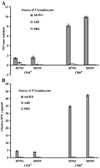Non-replicating adenovirus vectors expressing avian influenza virus hemagglutinin and nucleocapsid proteins induce chicken specific effector, memory and effector memory CD8(+) T lymphocytes
- PMID: 20557918
- PMCID: PMC2930022
- DOI: 10.1016/j.virol.2010.05.002
Non-replicating adenovirus vectors expressing avian influenza virus hemagglutinin and nucleocapsid proteins induce chicken specific effector, memory and effector memory CD8(+) T lymphocytes
Abstract
Avian influenza virus (AIV) specific CD8(+) T lymphocyte responses stimulated by intramuscular administration of an adenovirus (Ad) vector expressing either HA or NP were evaluated in chickens following ex vivo stimulation by non-professional antigen presenting cells. The CD8(+) T lymphocyte responses were AIV specific, MHC-I restricted, and cross-reacted with heterologous H7N2 AIV strain. Specific effector responses, at 10 days post-inoculation (p.i.), were undetectable at 2 weeks p.i., and memory responses were detected from 3 to 8 weeks p.i. Effector memory responses, detected 1 week following a booster inoculation, were significantly greater than the primary responses and, within 7 days, declined to undetectable levels. Inoculation of an Ad-vector expressing human NP resulted in significantly greater MHC restricted, activation of CD8(+) T cell responses specific for AIV. Decreases in all responses with time were most dramatic with maximum activation of T cells as observed following effector and effector memory responses.
Copyright 2010 Elsevier Inc. All rights reserved.
Figures







References
-
- Alexander DJ. Avian influenza viruses and human health. Dev. Biol. (Basel) 2006;124:77–84. - PubMed
-
- Ariaans MP, van de Haar PM, Lowenthal JW, van Eden W, Hensen EJ, Vervelde L. ELISPOT and intracellular cytokine staining: novel assays for quantifying T cell responses in the chicken. Dev. Comp. Immunol. 2008;32(11):1398–1404. - PubMed
-
- Babakir-Mina M, Dimonte S, Perno CF, Ciotti M. Origin of the 2009 Mexico influenza virus: a comparative phylogenetic analysis of the principal external antigens and matrix protein. Arch. Virol. 2009;154(8):1349–1352. - PubMed
-
- Beard CW. In: A laboratory manual for the isolation and identification of avian pathogens. 3rd ed. Purchase LHAHG, Domermuth CH, Pearson JE, editors. Dubuque, IA: Kendall/Hunt Publishing Co; 1989.
-
- Bohls RL, Smith R, Ferro PJ, Silvy NJ, Li Z, Collisson EW. The use of flow cytometry to discriminate avian lymphocytes from contaminating thrombocytes. Dev. Comp. Immunol. 2006;30(9):843–850. - PubMed
Publication types
MeSH terms
Substances
Grants and funding
LinkOut - more resources
Full Text Sources
Other Literature Sources
Research Materials
Miscellaneous

